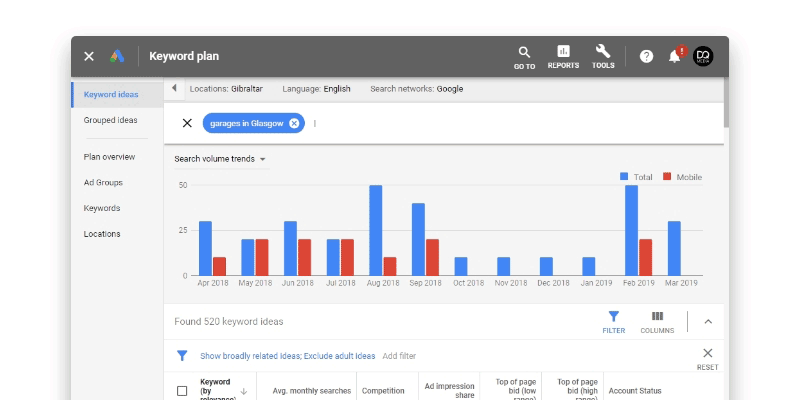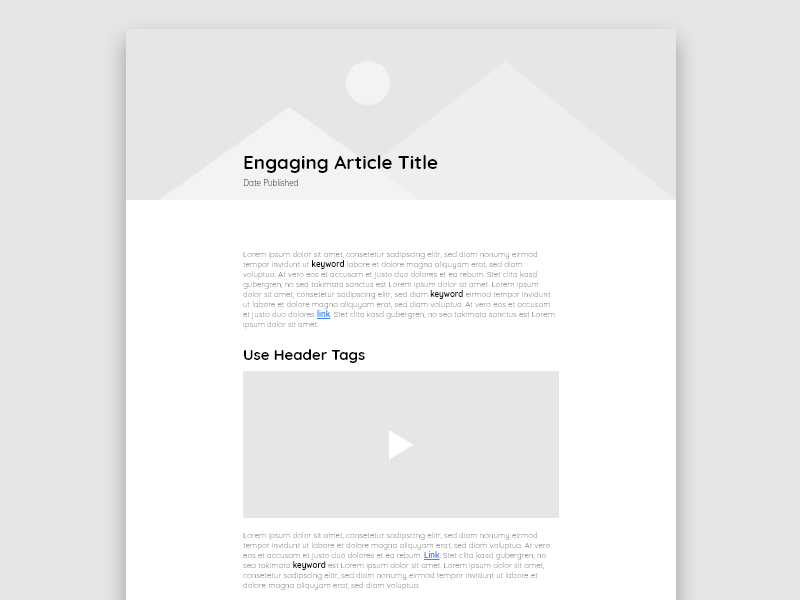25 April, 2019
When your goal is to achieve long-term organic growth, it can be difficult to know where to start; after all, even a quick perusal of Google offers up a whole library of tips and tricks. But how do you know what’s worth listening to? And what are the right things to focus your time and energy on?
If you want to grow naturally, then search engine optimisation – or SEO – is going to be a vitally important part of your overall strategy. And while everybody claims to be an expert in 2019, the truth is that as long as you stick to the basics, give your project plenty of attention, and keep things white hat (Google will – and does – penalize rogue operators), you should see steady and quantifiable growth.
So, if you’re looking for a strategy that can elevate you from small time player to a credible and authoritative voice, these are the best SEO tips and techniques to follow this year…
1. Start with Keywords
Keywords are the building blocks of all other SEO practices, in that if you choose the wrong ones, then everything else will come crashing down. You can share as many articles to as many people as you like, but if nobody is Googling those search terms, then they’re going to disappear into the void in the long term.
This, of course, means less traffic and, more importantly, less monetization opportunities for you, so you need to get your keywords right.
You should already have an idea of who your target audience is, so consider what they might be searching for and go from there. For example, if you run a garage in Glasgow, then ask yourself what your customers might be typing into Google; targeted terms like “garages in Glasgow”, “mechanics in Glasgow” and “MOT providers Glasgow” are a good place to start.

Once you’ve built up a good list, use free tools like Google’s Keyword Planner or SEMRush to see how popular those searches are. Ideally, you want to hit the sweet spot between sizeable search terms and low competition, especially when you’re starting out and you’re not yet an authoritative online presence.
Finally, you need to apply those keywords to your online content, which is where a skilled content creator can come in handy…
2. Produce Good Content
…which brings us to point two. In order to be found in Google’s (or indeed anybody else’s) search results, the crawl software actually needs some content to crawl; the written text on your pages, the videos you produce and publish, and the images you promote are all examples of content.
Search engines aren’t stupid, though. Through the keywords you have used, it can determine how useful your content is to readers and viewers, and will rank it accordingly; of course, there are other factors involved in this process, too, such as how authoritative your website is and how strong your backlink profile is (which we’ll discuss later), but ultimately it all boils down to whether you are offering people helpful solutions to their questions.

In fact, the approach of answering questions is a good way to attract traffic to your site. Consider our garage example; a lot of people search for things like “how often should I change my tyres”, or “when should I take my car for an MOT?” Use these long-tail keywords to write blog posts that will draw visitors (and advertising revenue) to your page, build authority and expose your business. As someone who knows and understands what they’re talking about, you will establish yourself as a credible source that other sites will link to.
This technique is known as content marketing and is a hugely effective way to drive growth; take our very own project CareerAddict, for example, where we have combined aggressive keyword research with high quality content production to increase our traffic and authority significantly over the last two years. Remember: the better your blog posts, videos and graphics, the easier it is to grow.
3. Get External Links
As mentioned, your backlink profile is a hugely important part of your SEO strategy, as it is where you will gain authority.
Authority is important when it comes to growth, as the higher your Domain Authority (or DA), the more preference you will receive from Google when your site is getting ranked. Top sites such as YouTube, Facebook and the BBC all have DAs in the high 90s, whereas you will likely start in the low 10s. So what’s the easiest way to start climbing?

To put it simply, by obtaining links to your site from other high DA sites. There are numerous ways to do this, but it’s important to be patient; buying links, for instance, is a black hat tactic that is frowned upon by Google and can result in your site getting penalized or even blacklisted.
Instead, the easiest – and safest – way to obtain links from other sites is to simply produce good content; take that blog post on changing your tyres, for instance. Other sites will link to this page as it is resourceful and helpful, which tells Google that you are an authoritative and credible link on that topic; as a result, it will bump you up the search rankings and your DA will increase, meaning your business page will increase, too.
Of course, just sitting around and hoping that a high DA site will pop by and give you a backlink is not enough – you need to be pro-active. You will need to share that article on social media, reach out to influencers and even approach other sites directly; do your research on who to approach, how to approach them, and what you’re going to offer in return for them to link to your site.
4. Remember Internal Links
External links are important, but you shouldn’t overlook your internal linking structure, either. Remember that crawl software that we talked about earlier? Well, the only way that they’re going to travel around your site is if you give them paths to follow – or, in simpler terms, if you link the pages on your website to one another.
Before you go and start inserting links left, right and centre, though, bear in mind that there is a strategic element to internal linking. You should imagine your most authoritative articles as branch (or master) articles and build around them, like a tree.

For example, let’s take again that article on when you should change your tyres, which we’ll assume is now performing well and has some authority due to the backlinks it’s getting. We might decide to explore some of the points in that article in greater detail, such as “how to notice the signs of tyre damage” or “what to do if you get a puncture”. These are good examples of how to build upon the success of your branch article and create a cluster of content around it (after all, the more pages you have on your site, the more traffic you can attract).
Remember: if you publish content and don’t bother linking to it in your other articles, then Google will have a hard time finding it. Besides, why should other sites link to your article when you can’t even be bothered to do so yourself?
5. Fine Tune Your On-Page SEO
On-page SEO is (or should be) a relatively quick part of your SEO process, but it is still hugely important. It generally consists of ensuring that your title, meta description, alt tags and anything else that appears on the page is optimised accordingly.
Your main keyword ideally needs to appear in the main title and at the start of your meta description (the small batch of text that appears under your title on the Google search results page), although if you’re not sure of how to do this, there are numerous free tools available online that can point you in the right direction.

On-page SEO should only take up a very small percentage of your time, but it’s worth paying attention to.
6. Make Use of Data
If you hadn’t already noticed, we now live in the data age; everything is collected, collated and analysed in order to drive strategy and aid decision-making. And guess what? Your growth strategy is no different.
There are almost countless resources that you can use to access information, but some of the basic and most effective tools we have tried and tested are:
- Google Analytics (free)
- Google Search Console (free)
- Keyword Planner (free)
- Moz Link Explorer (paid)
- AHREFs (paid)
- Screaming Frog (paid)
Search Console and Analytics, in particular, will tell you nearly everything you need to know, including how many people are looking at your site, how they got there, where they’re from, what times they’re looking and on what platform. This kind of information is invaluable in fine-tuning your approach; if you’re getting lots of visits from a particular location, for instance, then consider increasing your advertising in that area. If you’re finding that a lot of your traffic is coming from a particular source, then look at how you can maximise that.

While at first it can be a little overwhelming getting to grips with so much information, the data is there to inform and guide your decision making process, so invest a little time in finding out what these tools can tell you.
7. Recycle and Re-Purpose Content
As you publish more and more content, and build up a bigger library of pages on your site, you’ll soon come to realise that, for whatever reason, some of your content might not be performing. Alternatively, you might have written several articles that cover the same topic, and want to bring them together into one guide. In cases such as this, don’t be afraid to do some housekeeping; for instance, if you have several different articles that are being found for the same (or similar) keywords, then essentially all you are doing is competing against yourself.
Also, it’s a good idea to repurpose existing content that is performing well, too. In most cases, Google gives preference to pages that are up-to-date, so review your content and update it when necessary. For example, you might have written a guide last year about the best tyres on the market, but since then new and better tyres might have been released. If your article doesn’t reflect this, but somebody else’s does, then they may get preference in the search engine results.
8. Stay up to Date with Developments
As with all things digital, SEO – and online growth tactics in general – evolve quickly. While the tips and techniques discussed in this article are still the best practices to follow, it’s worth remembering that Google, Facebook and all the other platforms on which your strategy relies regularly change their algorithms.
This means that you need to keep abreast of changes and developments and consider how they might affect your approach. There are numerous good quality SEO blogs available, such as Moz, Search Engine Journal and SEMRush, so take the time to read through them and stay informed.

-
There are plenty of commentators and “experts” out there who can overcomplicate SEO, claiming to know insider “tricks” that can give you an advantage. But if you’re doing things properly and correctly, you won’t need to resort to trickery. Digital growth is all about patience and outreach; your site is not going to attract millions of visitors and 6-figure advertising revenues over night, but it can in the future if you build from a strong foundation.


